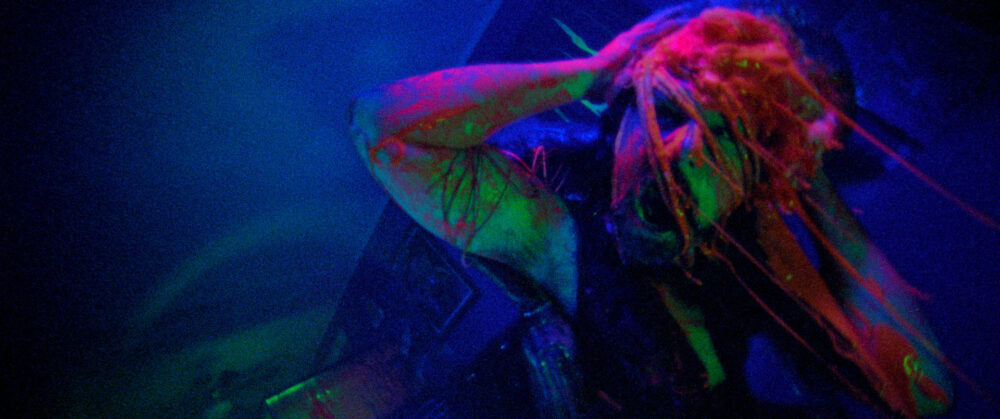The New Heavy Metal Movie Canon

At the climax of Jimmy And Stiggs, the latest 16mm-shot splatterfest from raconteur writer/director Joe Begos, a man’s head is split open by an alien parasite. The bug-eyed little monster crawls out of his skull and skitters across the floor, leaving behind a ruined corpse in a pool of blood. Seeing this carnage, the man’s still-living companion puts a pair of pliers in his mouth and tries to extract his own alien embryo implant before the same fate befalls him. The soundtrack to this gnarly bit of extraterrestrial Grand Guignol is “To Carry The Seeds Of Death Within Me,” the opening song from experimental doom duo the Body’s 2014 album I Shall Die Here, produced by the Haxan Cloak. There’s always been something otherworldly about the Body vocalist Chip King’s whistle-register death howls, so it was especially satisfying for Begos to make the connection explicit against a canvas of alien gore and strobe lights.
Moments like those are quintessentially Begos. In his short but prolific career, the Los Angeles-based director has made vampire films (Bliss), action thrillers (VFW), and holiday slashers (Christmas Bloody Christmas). Now, with Jimmy And Stiggs, he’s made his first foray into science fiction. But Begos’ true genre is the Heavy Metal Movie. The inclusion of a song by the Body is not what makes Jimmy And Stiggs a Heavy Metal Movie, though it helps. The Heavy Metal Movie is something that you know when you see it, and in Begos’ films, it’s impossible not to see it. He’s obsessed with metal, yes, but also classic horror, practical effects, gore, nudity, profanity, neon, drugs, booze, and the gritty, DIY grindhouse aesthetic you can only get by shooting on film. It’s fun to pick out the needle drops in his movies, but even when it’s playing on mute, a Joe Begos production is metal as fuck.
The Heavy Metal Movie as an art form has existed for as long as the music has, if not longer. Black Sabbath famously plucked their name from a 1963 Mario Bava anthology—a Heavy Metal Movie through and through, despite arriving the same year as the first two Beatles albums. The genre was articulated most thoroughly by the critic Mike “McBeardo” McPadden in his exhaustive (if exhaustingly titled) 2014 tome, Heavy Metal Movies: Guitar Barbarians, Mutant Bimbos & Cult Zombies Amok In The 666 Most Ear- And Eye-Ripping Big-Scream Films Ever! In his book, McPadden never spells out a dictionary definition for the Heavy Metal Movie, instead choosing to demonstrate its spirit by writing pithy, sometimes acerbic blurbs for 550 pages of examples. Each entry, from The Abominable Dr. Phibes to Zardoz, comes with a bullet-pointed list of qualities that grant it entry to the canon: Satanic Blood Orgy; Psycho ‘Nam Vets; Motorcycles; Barbarians; Extreme Gore. Special attention is paid to films whose cast includes metal musicians, or whose soundtrack features metal bands. That’s not enough, of course; there needs to be an aura of ineffable metalness around a movie for it to make the cut, and McPadden is an expert at sorting the wheat from the chaff. If you care about this kind of stuff, his book is the Bible.
McPadden died in 2020, and he was never able to put out what would have surely been a killer second edition of Heavy Metal Movies. Just think of some of the films that could have been added. There’s Robert Eggers’ The Northman, a blood-soaked Viking revenge flick that ends with a naked swordfight on a volcano. Damien Leone’s Terrifier franchise pushed the boundaries of onscreen gore in semi-mainstream moviemaking, and it gave the world a new slasher icon in the sadistic Art the Clown. Prano Bailey-Bond’s Censor took on the “video nasties” era of UK media censorship with gleeful abandon, and George Miller’s Mad Max: Fury Road gave us the Doof Warrior, possibly the most metal character in film this century. Metal itself isn’t anywhere close to its ’80s cultural pinnacle, when writing songs about The Evil Dead and The House By The Cemetery could help propel a band to a lucrative career. Yet it seems the Heavy Metal Movie is still alive and well.
This summer alone saw a trio of Heavy Metal Movies hit theaters—two that hit the mark, and one that badly missed it. Jimmy And Stiggs, which is available on VOD this Wednesday, comes close to the genre’s platonic ideal. In its opening moments, we get a first-person look at the apartment of down-on-his-luck horror director Jimmy (played by Begos), a claustrophobic space we won’t leave for the next 80 minutes. Jimmy’s walls are adorned with posters for Cannibal Holocaust and Sleep’s Dopesmoker, and a ’70s porno blares from the TV. He seems like he’s about to settle in for a nice, quiet night of abusing drugs and alcohol and screaming at his agent on the phone when he hears a strange sound. The next thing he knows, he’s levitating in his bedroom. When he wakes from a semi-lucid blackout, it’s the next day, and evidence begins to mount that he was abducted by aliens.
What follows is a full-blown cinematic freakout, delivered by a director who seems like he might be going insane right along with his character. Jimmy reaches out to his estranged filmmaking partner Stiggs (Matt Mercer) for help, and that’s when things really go off the rails. The apartment turns into an alien slaughterhouse, with the whiskey-pounding buddies employing a wide range of deadly implements to dispatch the “anchovy, sardine-looking fucking scumbags,” sending their neon-orange blood shooting out in every direction. The feverish intensity of the camerawork and the heightened performances make everything feel a bit wobbly and unreal; when I first saw Jimmy And Stiggs, I felt like I was finally seeing an accurate depiction of the early months of the pandemic. The film uncannily captures the experience of getting fucked up and going crazy in an apartment you can’t safely leave. (Begos shot the film at home during quarantine. I don’t think he’s getting his deposit back.) Some reviewers have complained that Jimmy And Stiggs peaks in intensity too early and loses steam because it doesn’t have anywhere else to go. I disagree. Begos is at his best when he’s operating at full blast, and Jimmy And Stiggs is almost entirely full blast.
Another note-perfect new addition to the Heavy Metal Movie canon is The Toxic Avenger Unrated, the Macon Blair-directed, Peter Dinklage-starring remake of the 1984 cult classic from Troma Entertainment. Blair’s film is, thank God, a shameless, tasteless gorefest, full of dick jokes and slapstick beheadings. It’s also much more explicitly metal than its more punk-coded inspiration. Prominent needle drops in the film include Savatage’s “Hall Of The Mountain King” and Motörhead’s “Overkill.” The latter is actually diegetic, and crucial to the plot: Dinklage’s Toxie sings it onstage before slaughtering a group of rap-metal henchmen called the Killer Nutz. (Blair casts himself as a denim-vested hesher in the crowd.) As with Jimmy And Stiggs, the metal sensibility of The Toxic Avenger Unrated goes far beyond the music. By evoking the glowing-green color palette and nuclear paranoia of ’80s thrash, Blair and Dinklage have made something that will be shown in the background at metal house parties until the end of time.
Much less successful was my least favorite movie of 2025 so far, the dreadful Spinal Tap II: The End Continues. The original This Is Spinal Tap is perhaps the single most iconic Heavy Metal Movie ever made. For 40 years, bands have recognized their own music biz travails in its richly detailed gags about life with a touring rock n’ roll show, and even its jokes about metal aesthetics and culture tend to land. (I’ve seen more than a few “Stonehenge” stage sets in my day.)
Unfortunately, Rob Reiner and Christopher Guest no longer have any idea what life is like for musicians, and so Spinal Tap II walls the fictional band up in a rehearsal space where they’re paid fawning tribute by guest stars like Paul McCartney, Elton John, and Questlove. The jokes mostly flop, but much more importantly, the idea that the medium-talented goobers who couldn’t sell 50 tickets at a zoo in the original film are, retroactively, a major influence on the most famous artists in the world just doesn’t hold water. The new renditions of Spinal Tap’s original songs, which were at least metal-adjacent in the original film, have also been neutered. Guest, Michael McKean, and Harry Shearer seem to be having fun noodling around on unplugged guitars, but any entertainment value for the audience is purely incidental. Spinal Tap II isn’t a Heavy Metal Movie, but I could forgive that. It isn’t watchable, either.
Heavy Metal Movies can certainly be made by non-metalheads – Stanley Kubrick almost certainly wasn’t jamming Judas Priest between takes on The Shining – but Jimmy And Stiggs and The Toxic Avenger Unrated show how much fun they can be when someone who understands the milieu is at the helm. Begos and Blair are both conversant in metal culture, and the stuff they chose to pull from it for their films rings true. Based on Letterboxd ratings and the scant critic reviews that I’ve seen, people who don’t love heavy metal seem to hate these movies. That’s fine. They’re not for them. They’re for you and me.
TEN NAILS THROUGH THE NECK
Heretoir – "Metaphor" (In Flames Cover)
Location: Augsburg, Germany
Subgenre: post-black metal
Reroute To Remain is a polarizing entry in the In Flames discography. The Gothenburg melodic death metal godfathers were coming off 2000’s Clayman, an album whose sugary choruses and groove-based riffs signaled the band’s interest in a true mainstream push. Reroute To Remain was that push. To be a little reductive, it was In Flames’ first foray into nü metal, something they’d incorporate on every album from that point forward.
I think Reroute To Remain is a great album, but I get why it’s controversial, and none of its 14 songs of conscious insanity (per its Hot Topic-ass subtitle) is more divisive than “Metaphor.” A delicate ballad led by acoustic guitar, violin, and Anders Fridén’s heavily accented, emo-ish clean vocals, it’s possibly the least metal song a Swedish death metal band had ever made up to that point.
Naturally, the German post-black metal band Heretoir cover “Metaphor” on their new album, Solastalgia. Heretoir played blackgaze long before that was a term, when the entirety of the scene was basically just them and Alcest. Main man David Conrad has never seemed especially concerned by black metal orthodoxy, blending post-rock and electronic sounds into the band’s widescreen black metal with abandon since the earliest Heretoir demos. He’s the perfect person to cover “Metaphor,” a song that infuriated metalheads 23 years ago for the sin of being too sensitive. We’ve come a long way in metal discourse since then; it’s entirely possible that people will largely embrace Heretoir’s “Metaphor,” which they honor with a soulful, shoegaze-inflected makeover. It still feels daring to me. [From Solastalgia, out now via AOP Records.]
Hyrde – "Æt ǣlċ heterōfe, Wæron þæt ōþer ǣþm"
Location: West Sussex, UK
Subgenre: black metal
“Æt ǣlċ heterōfe, Wæron þæt ōþer ǣþm” derives its title from a line in Beowulf that roughly translates to “hateful to each was the breath of the other.” The song is a retelling of the setup to the first encounter between Beowulf and Grendel, and it’s alive with the violent animus between those two most famous figures in Old English literature. Beowulf is a fitting subject for Hyrde, whose black metal calls back to two ancient traditions: the genre’s primitive origins in Scandinavia, and the early medieval period in his native England. On Bretwalda, his first full-length as a solo artist following an EP and a collaborative outing with Hemlokk, Hyrde evokes all that history with dark, mournful, subtly melodic black metal compositions, performed and produced with instinctive rawness. There are a few neofolk parts scattered about the track listing, but the album is at its best when Hyrde leans into pure, storming aggression. “Æt ǣlċ heterōfe, Wæron þæt ōþer ǣþm” is a maelstrom. [From Bretwalda, out now via Under the Dark Soil.]
Motherless – "Insect Politics"
Location: Chicago, Illinois
Subgenre: sludge metal/hardcore punk
From the tension-filled, squelching pick scrapes that introduce “Insect Politics” before the drums kick in, you should know what you’re getting with Motherless. This is deliberately disgusting music, dialed into discomfort. With a lineup comprising members of the Atlas Moth and Without Waves, Motherless certainly have experience making heavy music that’s designed to unsettle. But Do You Feel Safe? finds them striking a rawer nerve than they do in their primary bands. Where the gnarliest corners of crust, sludge, post-punk, and hardcore meet, you’ll find this admirably scuzzy album. [From Do You Feel Safe?, out now via Prosthetic Records.]
Sölicitör – "Crimson Battle Beast"
Location: Seattle, Washington
Subgenre: speed metal
“Into battle/ We’ve got no choice/ It’s time to shred.” So sings the perpetually Road Warrior-kitted Amy Lee Carlson early on in Sölicitör’s “Crimson Battle Beast.” I’m tempted to just leave it at that. It is time to motherfucking shred, and there’s almost nobody I’d trust at my flanks more than Sölicitör guitarists Patrick Fry and Matt Vogan. Speed metal can sometimes feel like a dead style, having been supplanted by more extreme sounds on one side and more melodic ones on the other. Sölicitör are one of a handful of newer bands keeping the style from becoming a museum piece. On Enemy In Mirrors, they make the case for speed metal as a distinct, vital art form. [From Enemy In Mirrors, out now via Gates of Hell Records.]
StumpTail – "From The Swamp, From The Estuary"
Location: Knoxville, Tennessee
Subgenre: psychedelic/progressive black metal
Nobody in the underground keeps me guessing quite like Ryan Clackner, whose work with projects like Primeval Well, Vile Haint, and Crestfallen Dusk finds him uncovering unholy new musical mutations with startling regularity. Clackner is a conservatory-trained jazz musician who loves, among other things, traditional American folk styles and European black metal. That sends him down rabbit holes that aren’t accessible to most people in the scene, and it finds him crawling back out with things like StumpTail. What the hell is StumpTail? Broadly, I guess it’s proggy, Southern rock-influenced psychedelic black metal, but I don’t even fully understand what that means, nor how Clackner has made it manifest so intuitively in the pair of 15-minute songs that comprise the bulk of Sonder Down Yonder. “From The Swamp, From The Estuary” proves that just because you’re scratching your head, that doesn’t mean you can’t shake your ass. It’s groovy, druggy, sexy, confounding, sometimes frightening, borderline inscrutable. Chalk up another win for black metal’s most liberated iconoclast. [From Sonder Down Yonder, out now via Moonlight Cypress Archetypes.]
Gawthrop – "Granfalloon"
Location: Seoul, South Korea
Subgenre: sludge/doom metal
In the parlance of the great Kurt Vonnegut, a “granfalloon” is “a proud and meaningless collection of human beings,” a group that affects a shared identity but whose supposed bonds are shallow and without purpose. (Vonnegut’s pet example was “Hoosiers,” a granfalloon of which he counted himself a member. By a similar token, I might suggest “metalheads.”) I don’t know if the Korean sludge band Gawthrop wrote “Granfalloon” about the Vonnegutian phenomenon or if they chose its title because it sounded cool and strange. If there are any lyrics besides moans of agony, I haven’t picked up on them. Either way, “Granfalloon” is a monster, a grimy slab of detuned doom inspired by Japanese bands like Corrupted and Coffins but even more spare in its arrangement. There’s a passage toward the end of the song’s seven-minute runtime where everything drops away except Minhwi Lee’s throbbing bass and a sample of what I imagine might be a Korean newscaster. It’s a stunning moment of austere power, and proof of what minimalism in metal can achieve when placed in capable hands. [From Kuboa, out now via Sentient Ruin Laboratories.]
Esoctrilihum – "Mauled, Swallowed, And Dissolved Into Nothingness By The 8-Eyed Psychopomp"
Location: France
Subgenre: avant-garde black metal
With an artist as prolific as Esoctrilihum, there’s a risk of the sheer quantity of the output reducing the music to a blur of white noise. The one-man project of the mad genius Asthâghul has put out dozens upon dozens of hours of music over the past eight years, all of it at least interesting, but I can’t pretend all of it has stuck with me. I have a feeling his new LP, Ghostigmatah, is going to stick. With a panoply of new instrumentation augmenting his jagged riffs and bugged-out vocals – including the hammered dulcimer and theremin that are so crucial to “Mauled, Swallowed, And Dissolved Into Nothingness By The 8-Eyed Psychopomp” – Asthâghul has issued a reminder that when it comes to maximalist, bizarro avant-garde black metal, he’s in a class of his own. [From Ghostigmatah – Spiritual Rites Of The Psychopomp Abxulöm, out now via I, Voidhanger Records.]
Green Carnation – "The Slave That You Are" (Feat. Grutle Kjellson)
Location: Kristiansand, Norway
Subgenre: progressive metal
Green Carnation and Enslaved have been circling one another in the Norwegian metal scene for decades. Both bands started in the violent crucible of second-wave black metal only to quickly make their way to more idiosyncratic visions. Today, both are among the most renowned progressive metal bands in the world. Enslaved keep one foot firmly planted in black metal, while Green Carnation draw more from gothic rock and doom. “The Slave That You Are,” from the first part of Green Carnation’s ambitious new album trilogy A Dark Poem, brings the two bands crashing into one another for the first time. The unmistakable roar of Enslaved’s Grutle Kjellson meets up with Green Carnation frontman Kjetil Nordhus in a glorious, surprisingly heavy duet. It’s not like I didn’t think this combination was going to work, but it still feels incredible to hear these two cherished voices of Norwegian metal weaving in and out of each other’s paths. It sounds like destiny fulfilled. [From A Dark Poem Part 1: The Shores Of Melancholia, out now via Season of Mist.]
Panopticon – "The Poppies Bloom For No King"
Location: Ely, Minnesota
Subgenre: atmospheric black metal
“The Poppies Bloom For No King” is my favorite Panopticon song to come out at least since 2021’s …And Again Into The Light. It’s everything I love about Austin Lunn in black metal mode — toweringly epic, patient to unfold, rich with atmosphere, fiery and righteous in its purpose and meaning. Lunn wrote the song as “a call to compassion, an expression of frustration at the political/social climate and increasing authoritarianism we are experiencing,” and he gives the song’s pivotal movement over to a speech on the immigrant experience written and recited by his Persian American friend, Bamse. Lunn is also giving 75% of proceeds from the release to the National Immigrant Justice Center and Al Lotro Lado, two organizations who give legal and humanitarian support to migrants who are being targeted by this country’s fascist regime. If the song sucked, it would still be worth buying. Fortunately, if not unexpectedly, it’s excellent. [From The Poppies Bloom For No King EP, out now via the artist.]
Die Spitz – "Throw Yourself To The Sword"
Location: Austin, Texas
Subgenre: hard rock/punk
I probably shouldn’t be worried, but I’m a little worried that Die Spitz are going to fall through the cracks. The Austin foursome play heavy, loud rock n’ roll that doesn’t neatly map onto any of the prevailing trends in punk, indie, hardcore, or metal. They certainly don’t sound like any of the garbage that currently dominates alternative radio. Foo Fighters dads would probably like them, but it’s going to take a while for their music to trickle down to them. Die Spitz’s curse is that they’re “just” a rock band, something that has probably never had less currency in critical circles or society at large. But I’m going to do my part to evangelize on their behalf, goddamn it.
Something To Consume is a real ripper of a debut album, one that treats the past three decades of rock history as an all-you-can-eat buffet of influence. Sometimes Die Spitz sound like Megadeth or High On Fire; sometimes they sound like L7 or Babes In Toyland or Tool or Soundgarden. Often, they sound like a combination of all the above. The thrashy “Throw Yourself To The Sword” is one of a handful of (almost) purely metal tracks on the album, so it gets the nod here, but you owe it to yourself to jam the whole album. It’s restored my faith in rock music — no subgenre required. [From Something To Consume, out now via Third Man Records.]
JOURNEY TO THE WORLD BEYOND
— doomsmoker (just memes) (@doomsmoker.bsky.social) September 8, 2025 at 10:13 PM



